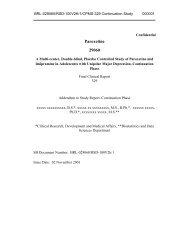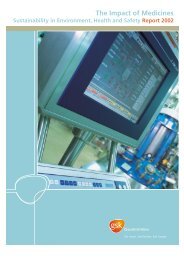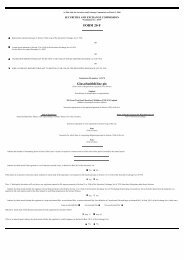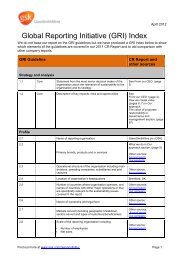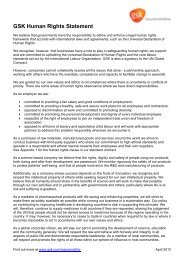GSK Annual Report 2002
GSK Annual Report 2002
GSK Annual Report 2002
You also want an ePaper? Increase the reach of your titles
YUMPU automatically turns print PDFs into web optimized ePapers that Google loves.
Competition – Consumer Healthcare<br />
The main competitors in the Group’s Consumer Healthcare markets<br />
include the major international companies Colgate-Palmolive,<br />
Johnson & Johnson, Pfizer, Procter & Gamble, Unilever and Wyeth.<br />
In addition, there are many other companies that compete with<br />
GlaxoSmithKline in selected markets.<br />
The major competitor products in over-the-counter (OTC)<br />
medicines are:<br />
• in the USA: Metamucil (laxative), Clearasil (acne treatment),<br />
Pepcid (indigestion) and private label smoking control<br />
products.<br />
• in the UK: Lemsip (cold remedy), Nurofen and Anadin<br />
(analgesics), and Nicorette and Nicotinell (smoking control<br />
remedies).<br />
In Nutritional healthcare the major competitors to Horlicks are<br />
Ovaltine and Milo malted food and chocolate drinks. The<br />
competitors to Ribena are primarily local fruit juice products while<br />
Lucozade competes with other energy drinks.<br />
GlaxoSmithKline holds leading global positions in all its key<br />
consumer product areas. Worldwide it is the second largest in Oral<br />
care and the third largest in OTC medicines. In Nutritional<br />
healthcare it holds the leading position in the UK, India and<br />
Ireland.<br />
Regulation – Pharmaceuticals<br />
The international pharmaceutical industry is highly regulated.<br />
National regulatory authorities administer a panoply of laws<br />
and regulations governing the testing, approval, manufacturing,<br />
labelling and marketing of drugs and also review the safety<br />
and efficacy of pharmaceutical products. These regulatory<br />
requirements are a major factor in determining whether a<br />
substance can be developed into a marketable product and the<br />
amount of time and expense associated with such development.<br />
Of particular importance is the requirement in many countries that<br />
products be authorised or registered prior to marketing and that<br />
such authorisation or registration be maintained subsequently.<br />
The national regulatory authorities in many jurisdictions, including<br />
the USA, the European Union, Japan and Australia, have high<br />
standards of technical appraisal and consequently the introduction<br />
of new pharmaceutical products generally entails a lengthy<br />
approval process.<br />
In the European Union, there are two procedures for obtaining<br />
marketing authorisations for medicinal products:<br />
• The Centralised Procedure, with applications made direct to<br />
the European Medicines Evaluation Agency and leading to an<br />
authorisation valid in all member states, is compulsory for<br />
products derived from biotechnology and optional for new<br />
active substances and other innovative medicinal products.<br />
• The Mutual Recognition Procedure, which is applicable to the<br />
majority of conventional medicinal products, operates by mutual<br />
recognition of national marketing authorisations; where<br />
agreement cannot be reached, it is resolved by procedure of<br />
binding arbitration.<br />
Description of business GlaxoSmithKline 11<br />
Grant of a marketing authorisation affords the Group a protection<br />
period during which a competitor cannot rely on confidential data<br />
in the regulatory file as a basis for its own marketing authorisation.<br />
The data protection period begins on the date an authorisation is<br />
first granted in the European Union and expires after ten years for<br />
authorisations granted via the Centralised Procedure, or ten or six<br />
years for authorisations granted via the Mutual Recognition<br />
procedure, depending on the country concerned.<br />
In the USA, the Drug Price Competition and Patent Term<br />
Restoration Act of 1984 (Hatch-Waxman) established the current<br />
framework for approval of generic drugs, including related patent<br />
and data protection provisions. Under Hatch-Waxman, the sponsor<br />
of an Abbreviated New Drug Application (ANDA) can receive<br />
marketing approval without submitting any safety or efficacy data.<br />
It can rely on the pioneer company’s extensive pre-clinical and<br />
clinical development data, provided the proposed generic drug has<br />
been demonstrated to be bioequivalent to the pioneer product.<br />
However, generic drug approvals are subject to data protection<br />
periods of five years for new chemical entities and three years for<br />
any modifications supported by new clinical studies. Moreover,<br />
under the provisions of Hatch-Waxman, the filing of an ANDA can<br />
trigger procedures that may allow patent holders to initiate patent<br />
infringement litigation with the significant procedural advantage of<br />
being assured that the FDA’s approval of the proposed generic<br />
product will be stayed for up to 30 months, pending resolution of<br />
the litigation. These procedures have generated litigation and<br />
controversy, particularly because, as currently applied, they have<br />
resulted in multiple, non-concurrent 30-month stays for some<br />
proposed generic products. The FDA has proposed changes to its<br />
regulations to address certain aspects of the procedures that have<br />
generated litigation and controversy, and reform legislation has<br />
also been proposed in the US Congress.<br />
In the USA, the second reauthorisation of the Prescription Drug<br />
User Fee Act came into effect on 1st October <strong>2002</strong> (PDUFA III).<br />
A recent General Accounting Office report to the Senate<br />
Committee on Health, Education, Labor and Pensions, has noted a<br />
gradual increase in the median time to gain approval for drugs<br />
with a standard review designation. Since 1995, the approval time<br />
for priority review drugs, judged by the FDA to represent a<br />
significant therapeutic advance, has remained constant, with a<br />
median time for approval of six months.<br />
There has been an increasing gap between the approval times for<br />
priority and standard applications. The approval time for drugs<br />
designated as a standard review reached a low of about<br />
13 months in 1998 before rising to about 20 months in 2000<br />
and 2001.<br />
It remains to be seen if the substantial additional resources funded<br />
under PDUFA III will result in a reduction of overall approval times<br />
for all drugs and biologics. The review times for certain biologics,<br />
other than vaccines, may be substantially impacted by a recently<br />
announced consolidation of the review activities to the Center for<br />
Drug Evaluation and Research. These activities had previously been<br />
carried out by the Center for Biologics Evaluation and Research.








